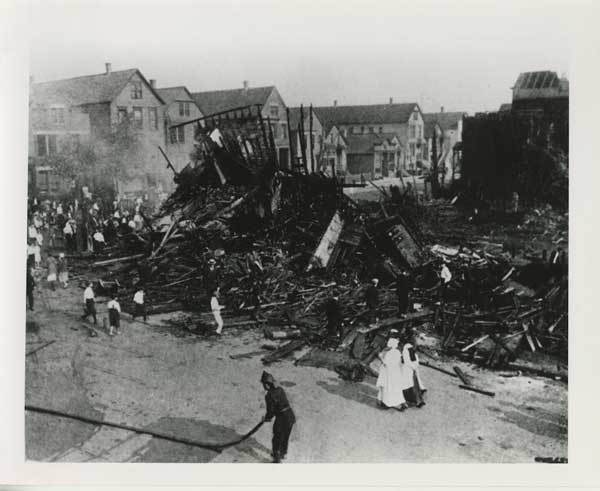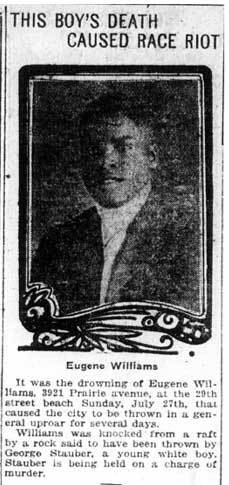From July 27–August 3, 1919, mobs of mostly white Chicagoans erupted in a week of violence and destruction that left thirty-eight dead and over five hundred wounded. Chicago’s Black communities bore the brunt of this violence.
In the early 1900s Black Americans left the Jim Crow South in hopes of finding better treatment, better wages, and an easier path to political participation in Midwestern, Northeastern, and Western cities. Chicago was one of these cities that saw new Black residents move in, many attracted by factory jobs available due to increased demand caused by World War I. Hoping for better treatment outside of the South, Chicago’s new Black residents arrived in a city that was less than welcoming. They were met by overt violence as well as segregationist policies that kept most Black Chicagoans confined to a small area on the city’s South Side.
 Residents of Chicago’s Back of the Yards neighborhood survey damage to their community (Abraham Lincoln Presidential Library and Museum).
Residents of Chicago’s Back of the Yards neighborhood survey damage to their community (Abraham Lincoln Presidential Library and Museum).
On the afternoon of July 27, a Black Chicago teenager named Eugene Williams was keeping cool on a hot summer day by floating on a raft with friends at the local beach. As the teens enjoyed their day, they crossed an invisible dividing line separating the Black beach from the white beach. White beachgoer George Stauber threw rocks at the Black teens; one rock hit Williams, causing him to fall off the raft and drown in the lake.
Police refused to arrest Stauber. When they arrived at the beach to confront a group of African Americans who gathered that evening, a Black man fired a gun and was killed by officers who returned fire. News of the incident spread, and white Chicagoans rushed into Black neighborhoods burning, shooting, and beating as they went. African Americans fought back to protect their families and their communities.
Of the thirty-eight killed in the seven days of violence, twenty-three were Black. Black people also accounted for 342 of the 537 injuries. Despite the higher number of Black victims and the fact that white mobs were terrorizing their neighborhoods, Black people accounted for two-thirds of those arrested and indicted for participating in the violence.
 From the August 30, 1919, Chicago Defender (Courtesy of Newberry Library’s Chicago 1919 Project)
From the August 30, 1919, Chicago Defender (Courtesy of Newberry Library’s Chicago 1919 Project)
This was part of a larger pattern of racial violence in the summer of 1919, spurred in part by the return home of Americans who had served in World War I to find increased competition for their old factory jobs. During that summer, race riots also broke out in Arkansas, Nebraska, Tennessee, Texas, and Washington D.C.
In 2019, The Newberry Library along with thirteen partners helped Illinoisans confront the history of these events through the Chicago 1919 Project. The project engaged the public in programs to help confront Chicago’s history of systemic racism, with the ultimate goal of recognition, reconciliation, and imagining possible paths forward. Explore the Chicago 1919 Project at Chicago1919.org.
Jacob K. Friefeld
Research Historian